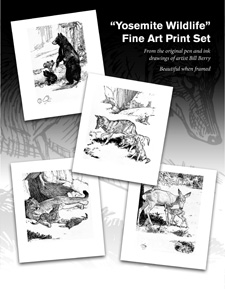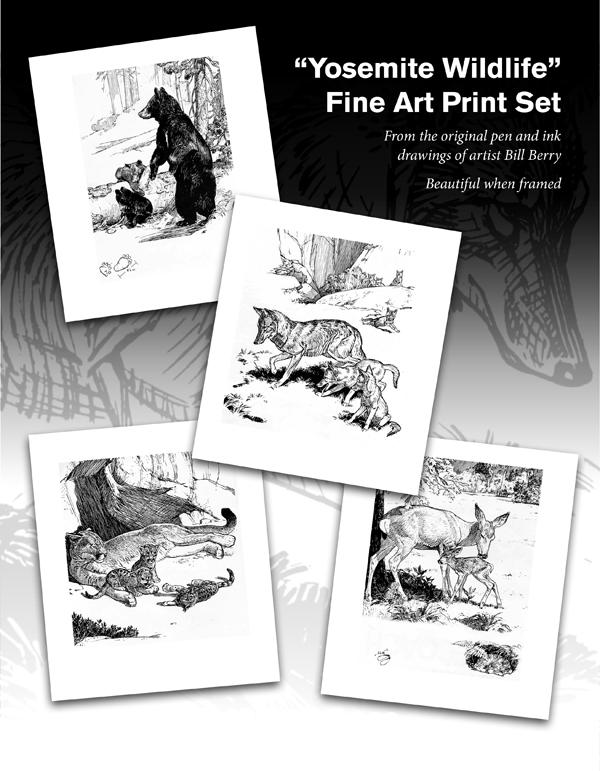Yosemite Animal Prints
Bill Berry was one of the premier
wildlife artists of his time, and these Yosemite Animal Prints are an exquisite example of his artistic genius. His use of the pen and ink medium captured his
subjects with a life-like realism rarely seen today. These are especially endearing with the subjects being mothers and their babies.
This beautiful set of high quality prints, capture four of the larger mammals of the Sierra. Three of these, the Mountain Coyote, Mule Deer and Black Bear are quite commonly seen. The fourth, the Mountain Lion, almost never.
Each print is 11 x 14 in size and printed on heavy stock. Beautiful framed!
Place your cursor over the image below and then follow the link to get your set today! (Perfect for babies room).
A Little More About These Yosemite Mammals
There are over thirty Yosemite Mammals, from the Black Bear...the largest, to the ferocious and thankfully tiny Shrew. Most are animals that a casual visitor to Yosemite will never notice. Some are nocturnal like the Bats and the Flying Squirrel and are busy during the night time. Others are burrowers like the Pocket Gopher, the Deer Mouse and his cousin the Meadow Mouse.
But with exception of the Mountain Lion which is incredibly wary and is almost never seen by man, the four examples featured in Bill Berry's Yosemite Animal Prints are seen quite often.
Yosemite's Black Bear...Here Comes Trouble!
The Black Bear would have to be considered to be the "animal icon" of
Yosemite. Not only is he big and impossible to ignore, but he has no
natural enemies and is always on the look out for a snack...Wherever he
can find it.
He is so focused on his next meal, that serious efforts must be made to protect not only a campers supplies but whatever they may be kept in...including the car.
Through the years since cars first came to Yosemite, so many images have been taken of cars opened like tin cans by black bears, that they are impossible to count. There must be thousands.
Like most mammals in Yosemite, the black bear must be treated with respect. He can be unpredictable and very dangerous. Humans cannot outrun, out swim or out climb him...It is best to not find yourself in a situation where this might be necessary.
Observe him from a distance, and be especially wary when mother bears have cubs.
For more about Yosemite's Black Bear, follow this link to the Black Bear page.
The Beautiful Mule Deer
Memories of frosty fall mornings, as the rising sun first warmed grazing herds of Mule Deer in the meadows of Yosemite valley will never fade for me. Most mule deer are experienced in this way, in a meadow and from a distance.
The Mule Deer is a particularly beautiful animal that was given his name because of his big mule-like ears. The big ears are not only especially useful when listening for things in their surroundings, but are an accurate indicator of what frame of mind they are in and how they are feeling about things.
Almost like signal flags, they are erect and facing forward if listening for possible dangers. They are flattened sideways against his head when he is angry. If he is hiding he folds them back along the sides of his head and out of the way.
The male "buck" displays an impressive rack of antlers on his head with which he will often fight. Many people are unaware however, that the female doe and the male buck will both strike out with their feet to defend themselves. Their hooves are sharp and do a lot of damage.
Sometimes when defending their babies, mother mule deer have been seen driving coyotes away with accurately placed kicks!
For more about Yosemite's Mule Deer, follow this link to the Mule Deer page.
The Mountain Coyote...Master Hunter
Like the Mule Deer, Yosemite's Mountain Coyote is most often seen in meadows and from a distance. Unlike the deer though he is usually hunting and often with other coyotes.
Small rodents are their main staple, and coyotes will often work in teams to scare and flush out a potential meal from the tall meadow grasses. They are very intelligent and modify their hunting behaviors base upon where they are at the time and what type of prey lives where they are.
Larger groups of coyotes will sometimes attack larger prey including deer, but they know better than to attack a healthy adult. Young fawns are especially vulnerable to attack by large numbers of coyotes as are injured or sick and weakened adult deer.
Cousins of the domesticated dog, it is especially enjoyable to watch coyote behavior, since some of the similarities between the two are often striking!
For more about Yosemite's Mountain Coyote, follow this link to the Mountain Coyote page.
The Misunderstood Mountain Lion
Even those who have lived in Yosemite National Park for many years rarely claim to have seen a mountain lion. Most have never heard one, and very few can say that they have even seen signs of where one has been.
Not that long ago these beautiful big cats were actively hunted by designated Mountain Lion hunters that were employed by the State of California. These hunters were not only on salary, but were paid a bounty on top of it, with a premium paid for younger cub-bearing aged females.
Hundreds were take by the hunters and their dogs, and it is no wonder that what has always been an elusive animal, has learned to be even more afraid of humans.
But we are told that they still exist in the higher elevations of Yosemite's wilderness areas, though their numbers are certainly not what they once were.
For more about Yosemite's Mountain Lion, follow this link to the Mountain Lion page.
To return to the Home Page from Yosemite Animal Prints Click Here
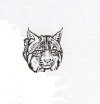
Awani Press Publications At A Glance
Meet The Furry Friends Of Yosemite
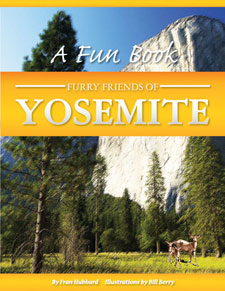
A Childrens Activity Book-Read, Color And Learn
Cowboys Indians And The Wild West In Yosemite
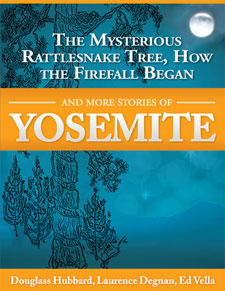
So...How DID The Firefall Begin?
Spend A Day With Tupi
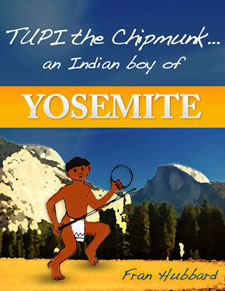
Bill Berry's Prints Return
